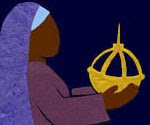The theme of my D&C readings this week was the coming forth of the Book of Mormon. As I reflected on them, I got to thinking: Although it became conventional in the 20th century to start the story of the Restoration with the First Vision, the production of the Book of Mormon is really the founding event of Mormonism, because it's the event around which the first Mormon faith community formed. So what would it look like if Mormons began to annually celebrate that event, the way Christians celebrate foundational events like the Incarnation (Christmas), the Passion and Resurrection (Holy Week and Easter), or the outpouring of the Spirit on the infant church (Pentecost)?
The stories and symbols that have come to be associated with Christmas and Easter have powerful, iconic, mythic resonances: The search for an empty inn, the baby in the manger, the angel appearing to the shepherds, the Magi following a star. The last supper, the washing of feet, the night watch in the garden, the road to Calvary, the empty tomb. Does the story of Moroni's appearances, the unearthing of the golden plates, the miraculous translation—does that story have the same kind of iconic staying power? Could it sustain the kind of devotional reflection and personal/symbolic application and ritual reenactment that the stories around Christmas and Easter do? Could people develop the same kind of intimate, sentimental attachment to this story that people have for the Christmas and Easter stories? Could it sustain the production of local pageants and processions and special family customs and traditional decorations and carols and oratorios and greeting cards, such as have emerged over generations around Christmas and Easter? Christmas and Easter are powerful in part because in the Northern hemisphere they developed seasonal associations: the light in the darkness of mid-winter, the coming of spring. What seasonal associations might develop around an annual celebration that remembers Moroni's appearance on the occasion of the autumn equinox—which in the Southern hemisphere would be the coming of spring?
It seems to me that the closest we have to any of what I'm imagining is the Hill Cumorah pageant, but that isn't a locally reenacted event (not like a ward Christmas pageant, or live Nativity scene, or Passion play, or sunrise service), and it isn't a celebration of a particular date.
I'd like to think that the "Moroni story" (let's call it that for shorthand) has iconic staying power. The unearthing of a lost record. Truth from the earth. A voice from the dust. A message from heaven. The beginning of a marvelous work. A sign of the fulfillment of God's promises. I think, in fact, that Tony Kushner's adaptation of the story in Angels in America demonstrates its iconic staying power, though I'm also sure that most Mormons don't particularly appreciate what he did with the story. But in Kushner's hands, at least, the story has deep emotional, symbolic resonance—the kind of resonance that, in another context, makes people want to set up a Nativity scene year after year and sing "Silent Night" by candlelight. That kind of emotional, symbolic force is largely, perhaps entirely, dissipated when the Moroni story is presented as "evidence" of the prophetic authority of Joseph Smith and the LDS Church (the way the current missionary discussions do) or when intellectuals get bogged down in debates about the story's historicity.
I hope—and I mean that word in a rather fervent sense—that as Mormonism continues to grow internationally, you'll see the emergence of local and regional customs celebrating foundational events like Moroni's story in ways that reflect cultural diversity and grassroots-level devotion. The centralized mechanisms of correlation can't produce that kind of thing. Only the Spirit blowing where it will.
************
End of soapbox. To finish this week's post, let me transcribe some notes I jotted down during the week's reading—a list of passages that speak of the coming forth of the Book of Mormon in terms of themes that express what the Book of Mormon and the Moroni story mean to me.
JS-H 1:39 - The Book of Mormon plants in the hearts of the children the promises made to the fathers. It teaches us to look to tradition—but also to translate past tradition into the idiom of our own day.
D&C 3:3 - The coming forth of the Book of Mormon is a sign that God's work is not frustrated.
D&C 3:19 - The Book of Mormon comes forth so that the promises of the Lord to his people can be fulfilled.
D&C 5:9 - The Book of Mormon comes forth for certain purposes that will only be made known to future generations.
D&C 5:19-20 - The Book of Mormon comes forth as part of a revelation trying to warn the human family against self-destruction.
D&C 10:48-49 - The Book of Mormon is an instrument for preaching Christ's good news.
D&C 10:52 - The Book of Mormon comes forth not to destroy what people already have, but to build it up.
D&C 10:59-61 - The Book of Mormon teaches us that people we might not have thought of as belonging to God's fold, do; God has been working among them in ways we did not know about.
D&C 10:63, 65 - The Book of Mormon is meant to be an instrument for reducing contention, for bringing people together.
D&C 17:4, 9 - The Book of Mormon comes forth to bring about God's righteous purposes for the human family.
D&C 84:57 - The Book of Mormon teaches us to bring forth fruits meet for God's kingdom.
D&C 84:61 - We should bear testimony of what has been communicated to us through the Book of Mormon.
D&C 128:19-21 - The Book of Mormon's coming forth is a voice of gladness from Cumorah: God reigns! The prophets' visions will be fulfilled! Angels provide consolation and confirm our hope.
Sunday, February 1, 2009
Subscribe to:
Post Comments (Atom)


No comments:
Post a Comment